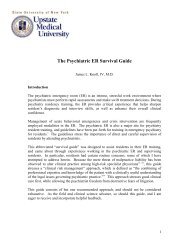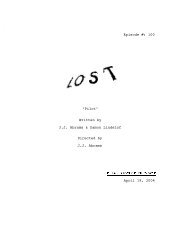Synchronicity Cambray
Synchronicity Cambray
Synchronicity Cambray
Create successful ePaper yourself
Turn your PDF publications into a flip-book with our unique Google optimized e-Paper software.
phylogenetic evolution it has been replaced by the better method<br />
of giving information with the help of signals which are picked up<br />
by the sense organs. But the older method might have persisted<br />
in the background and still be able to put itself into effect under<br />
certain conditions—for instance, in passionately excited mobs. 6<br />
Freud goes on in the next paragraph to extend this mechanism to<br />
children:<br />
If there is such a thing as telepathy as a real process, we may suspect<br />
that, in spite of its being so hard to demonstrate, it is quite a<br />
common phenomenon. It would tally with our expectations if we<br />
were able to point to it particularly in the mental life of children.<br />
Here we are reminded of the frequent anxiety felt by children<br />
over the idea that their parents know all their thoughts. 7<br />
Similarly, Jung was drawn to insect examples for synchronicity (the<br />
famous Scarabaeid beetle story) and for explicating his archetype theory<br />
(the leaf-cutting ant and yucca moth examples he borrowed from<br />
Conway Lloyd Morgan’s Habit and Instinct, see Hogenson, “The Baldwin<br />
Effect,” for details). Perhaps this interest of the founders in insects<br />
and mental life resides in an intuition that there have been two major<br />
approaches in evolution to the development of intention and purpose:<br />
collective behaviors requiring rapid communication between<br />
organisms, while relying on self-organizing properties of collective<br />
systems and alternatively an internalization of separate units to reside<br />
in a single individual who would also retain, à la Freud, vestiges of<br />
this other communication system—the human brain with its roughly<br />
hundred billion neurons being a relevant example.<br />
Jung’s notion of the Self also can be read as an emergent property<br />
of the psyche, and as I’ve previously shown synchronicity is consistent<br />
with an emergentist paradigm. In recent years growing numbers of<br />
analytical psychologists have begun to apply systems and complexity<br />
theories to the Jungian approach. In addition to the Hogenson paper<br />
already mentioned, a few other authors whose writings have appeared<br />
in the Journal of Analytical Psychology over the last several years with<br />
( 48 ) Chapter 3









